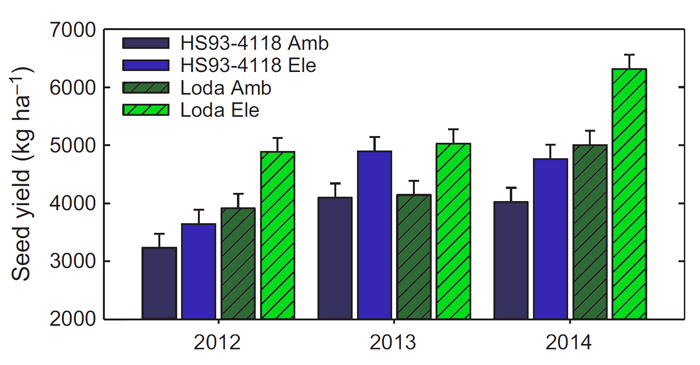| Follow @co2science |
Paper Reviewed
Sanz-Sáez, A., Koester, R.P., Rosenthal, D.M., Montes, C.M., Ort, D.R. and Ainsworth, E.A. 2017. Leaf and canopy scale drivers of genotypic variation in soybean response to elevated carbon dioxide concentration. Global Change Biology 23: 3908-3920.
In the words of Sanz-Sáez et al. (2017), "in order to maximize yields under future atmospheric CO2 [concentrations], we need to identify and study crop cultivars that respond most favorably to elevated CO2 and understand the mechanisms contributing to their responsiveness." And that is exactly what the team of six researchers set out to do.
Their crop of choice was soybean (Glycine max), and they grew two of its cultivars (Loda and HS93-4118) for three seasons (2012-2014) at the SoyFACE research facility in Champaign, IL, USA, under ambient and elevated (~600 ppm) CO2 concentrations, with the elevated CO2 plots being fumigated with FACE technology during the daylight hours only. During each growing season the authors measured various developmental stage and yield traits to investigate the physiological mechanisms associated with the annual yield response of the two cultivars. And what did those measurements reveal?
In terms of seed yield, which is arguably the most important parameter of the crop, the approximate 200 ppm increase in atmospheric CO2 enhanced HS93-4118 yields by 13, 22 and 19 percent and Loda yields by 25, 23 and 26 percent in 2012, 2013 and 2014, respectively (see figure below). Sanz-Sáez et al. additionally report that radiation use efficiency and harvest index were both significantly higher in the Loda cultivar at both ambient and elevated CO2 than in HS93-4118; but they note that "greater plasticity in the response of FPARi [the efficiency by which light energy is intercepted by the crop canopy] likely contributed to a greater seed yield response to elevated CO2. Finally, they report that "photosynthetic capacity was also greater in Loda than HS93-4118, supporting the hypothesis that increasing photosynthetic C gain could drive greater productivity in both current and future CO2 concentrations."
All things considered, therefore, it would appear that both soybean cultivars will benefit from increasing atmospheric CO2 concentrations, with the Loda cultivar experiencing the greatest yield enhancement.

Figure 1. Average seed yield for the two soybean cultivars in 2012, 2013 and 2014 under ambient (Amb) and elevated (Ele) CO2 concentrations. Adapted from Sanz-Sáez et al. (2017).




